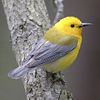Hornbill
| Hornbills | ||||||||||
|---|---|---|---|---|---|---|---|---|---|---|
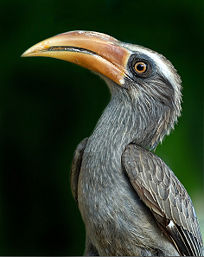 Malabar Grey Hornbill
Ocyceros griseus |
||||||||||
| Scientific classification | ||||||||||
|
||||||||||
| Genera | ||||||||||
|
14, see text |
Hornbills (Bucerotidae) are a family of bird found in tropical and sub-tropical Africa and Asia. They are characterized by a long, down-curved bill which is frequently brightly-coloured and sometimes has a casque on the upper mandible. Both the common English and the scientific name of the family refer to the shape of the bill, "buceros" being "cow horn" in Greek. In addition, they possess a two-lobed kidney. Hornbills are the only birds in which the first two neck vertebrae (the axis and atlas) are fused together; this probably provides a more stable platform for carrying the bill.[1] The family is omnivorous, feeding on fruit and small animals. They are monogamous breeders nesting in natural cavities in trees and sometimes cliffs. A number of species of hornbill are threatened with extinction, mostly insular species with small ranges.
Contents |
Taxonomy
There are two subfamilies: the Bucorvinae contain the 2 ground-hornbills in a single genus, whereas the Bucerotinae contain all other taxa. In the Sibley-Ahlquist taxonomy, hornbills are separated from the Coraciiformes as a separate order Bucerotiformes, with the subfamilies elevated to family level. Given that they are almost as distant from the rollers, kingfishers and allies as are the trogons,[2] the arrangement chosen is more a matter of personal taste than any well-established taxonomic practice. All that can be said with reasonable certainty is that placing the hornbills outside the Coraciiformes and the trogons inside would be incorrect.
Distribution and habitats
The Bucerotidae include some 57 living species, though a number of cryptic species may yet be split in some insular forms. Their distribution ranges from Africa south of the Sahara through tropical Asia to the Philippines and Solomon Islands. Most are arboreal birds, but the large ground-hornbills (Bucorvus), as their name implies, are terrestrial birds of open savanna. Of the 23 species found in Africa 13 of these species are birds of the more open woodlands and savanna, and some species even occur in highly arid environments. The remaining species are found in dense forests. This contrasts with Asia, where a single species occurs in open savanna and the remainder are forest species.[3]
Description
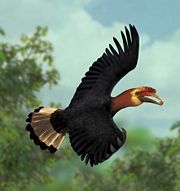
They hornbills show considerable variation in size as a family, ranging in size from the Black Dwarf Hornbill (Tockus hartlaubi), at 102 grams (3.6 oz) and 30 cm (1 foot), to the Southern Ground-hornbill (Bucorvus leadbeateri), at up to 6.2 kg (13.6 lbs) and 1.2 m (4 feet).[3] Males are always bigger than the females, though the extent to which this is true varies dependent upon species. The extent of sexual dimorphism also varies with body parts, for example the difference in body mass between males and females is between 1-17%, but the variation is 8-30% for bill length and 1-21% in wing lenth.[3]
The most distinctive feature of the hornbills is the heavy bill, supported by powerful neck muscles as well as by the fused vertebrae. [3] The large bill assists in fighting, preening, and constructing the nest, as well as catching prey. A feature unique to the hornbills is the casque, a hollow structure that runs along the upper mandible . In some species it is barely perceptible and appears to serve no function beyond reinforcing the bill. In other species it is quite large, is reinforced with bone, and has openings between the hollow centre allowing serve as a resonator for calls.[1] In the Helmeted Hornbill the casque is not hollow but is filled with ivory and is used as a battering ram used in dramatic aerial jousts.[4] Aerial casque-butting has also been reported in the Great Hornbill.[5][6]
The plumage of hornbills is typically black, grey, white, or brown, although typically offset by bright colours on the bill, or patches of bare coloured skin on the face or wattles. Some species exhibit sexual dichromatism; in the Abyssinian Ground-hornbill, for example, pure blue skin on the face and throat denotes an adult female, and red and blue skin denotes an adult male. The calls of hornbills are loud, and vary distinctly between different species.[1]
Hornbills possess binocular vision, although unlike most birds with this type of vision the bill intrudes on their visual field.[7] This allows them to see their own bill tip and aids in precision handling of food objects with their bill. The eyes are also protected by large eyelashes which act as a sunshade.
Behaviour
Hornbills are diurnal, generally travelling in pairs or small family groups. Larger flocks sometimes form in the non-breeding season. The largest assemblages of hornbills form at some rossting sites, where as many as 2400 individual birds may be found.
Diet
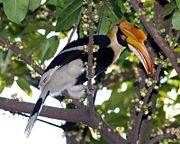
Hornbills are omnivorous birds, eating fruit, insects and small animals. They cannot swallow food caught at the tip of the beak as their tongues are too short to manipulate it, so they toss it back to the throat with a jerk of the head. While both open country and forest species are omnivorous, species that specialise in feeding on fruit are generally found in forests while the more carnivorous species are found in open country.[3] Forest living species of hornbills are considered to be important seed dispersers.[8]
In some instances hornbills defend a fixed territory.[1] Territoriality is related to diet; fruit sources are often patchily distributed and require long distance travel in order to find, thus species that specialise in fruit are less territorial.
Breeding
Hornbills generally form monogamous pairs, although some species engage in cooperative breeding. The female lays up to six white eggs in existing holes or crevices, either in trees or rocks. The cavities are usually natural, but some species may nest in the abandoned nests of woodpeckers and barbets. Nesting sites may be used in consecutive breeding seasons by the same pair. Before incubation, the females of all Bucorvinae—sometimes assisted by the male—begin to close the entrance to the nest cavity with a wall made of mud, droppings and fruit pulp. When the female is ready to lay her eggs, the entrance is just large enough for it to enter the nest, and after she has done so, the remaining opening is also all but sealed shut. There is only one narrow aperture, big enough for the male to transfer food to the mother and eventually the chicks. The function of this behaviour is apparently related to protecting the nesting site from rival hornbills.[9] The sealing can be done in just a few hours, at most it takes a few days. Having sealed the nest it takes a further five days for the first egg to be laid. Clutch size varies from one or two eggs in the larger species to up to eight eggs for the smaller species. During the incubation period the female undergoes a complete moult. When the chicks and the female are too big to fit in the nest, the mother breaks out, then both parents feed the chicks.[1] In some species the mother rebuilds the wall, whereas in others the chicks themselves rebuild the wall unaided. The ground-hornbills are conventional cavity-nesters instead.[1]
Associations with other species
A number of hornbills have associations with other animal species. For example hornbills in Africa have a mutualistic relationship with Dwarf Mongooses, in which they forage together and warn each other of nearby birds of prey and other predators.[10] Other relationships are commensal, for example following monkeys or other animals and eating the insects flushed up by them.[11]
Species list in taxonomic order
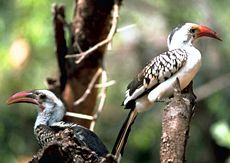
Tockus erythrorhychus
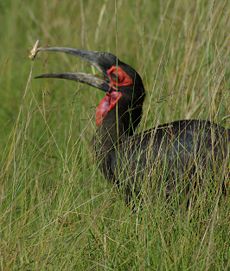
This is a list of hornbill species, presented in taxonomic order.
Subfamily Bucerotinae
- Genus Tropicranus (sometimes included in Tockus)
- White-crested Hornbill Tropicranus albocristatus
- Genus Tockus
- Black Dwarf Hornbill Tockus hartlaubi
- Red-billed Dwarf Hornbill Tockus camurus
- Monteiro's Hornbill Tockus monteiri
- Red-billed Hornbill Tockus erythrorhynchus
- Eastern Yellow-billed Hornbill Tockus flavirostris
- Southern Yellow-billed Hornbill Tockus leucomelas
- Jackson's Hornbill Tockus jacksoni
- Von der Decken's Hornbill Tockus deckeni
- Crowned Hornbill Tockus alboterminatus
- Bradfield's Hornbill Tockus bradfieldi
- African Pied Hornbill Tockus fasciatus
- Hemprich's Hornbill Tockus hemprichii
- African Grey Hornbill Tockus nasutus
- Genus Ocyceros
- Malabar Grey Hornbill Ocyceros griseus
- Ceylon Grey Hornbill Ocyceros gingalensis
- Indian Grey-Hornbill Ocyceros biostris
- Genus Anthracoceros
- Malabar Pied Hornbill Anthracoceros coronatus
- Oriental Pied Hornbill Anthracoceros albirostris
- Black Hornbill Anthracoceros malayanus
- Palawan Hornbill Antracoceros marchei
- Sulu Hornbill Anthracoceros montani
- Genus Buceros
- Rhinoceros Hornbill Buceros rhinoceros
- Great Hornbill Buceros bicornis
- Rufous Hornbill Buceros hydrocorax
- Genus Rhinoplax (sometimes included in Buceros)
- Helmeted Hornbill Rhinoplax vigil
- Genus Anorrhinus
- Austen's Brown Hornbill, Anorrhinus austeni
- Tickell's Brown Hornbill, Anorrhinus tickelli
- Bushy-crested Hornbill Anorrhinus galeritus
- Genus Penelopides
- Luzon Hornbill Penelopides manillae
- Mindoro Hornbill Penelopides mindorensis
- Visayan Hornbill Penelopides panini
- Samar Hornbill Penelopides samarensis
- Mindanao Hornbill Penelopides affinis
- Sulawesi Hornbill Penelopides exarhatus
- Genus Berenicornis (sometimes included in Aceros)
- White-crowned Hornbill Berenicornis comatus
- Genus Aceros
- Rufous-necked Hornbill Aceros nipalensis
- Wrinkled Hornbill Aceros corrugatus
- Writhed Hornbill Aceros leucocephalus
- Rufous-headed Hornbill Aceros waldeni
- Knobbed Hornbill Aceros cassidix
- Genus Rhyticeros (sometimes included in Aceros)
- Wreathed Hornbill Rhyticeros undulatus
- Narcondam Hornbill Rhyticeros narcondami
- Sumba Hornbill Rhyticeros everetti
- Plain-pouched Hornbill Rhyticeros subruficollis
- Papuan Hornbill Rhyticeros plicatus
- Genus Bycanistes (sometimes included in Ceratogymna).
- Trumpeter Hornbill Bycanistes bucinator
- Piping Hornbill Bycanistes fistulator
- Silvery-cheeked Hornbill Bycanistes brevis
- Black-and-white-casqued Hornbill Bycanistes subcylindricus
- Brown-cheeked Hornbill Bycanistes cylindricus
- White-thighed Hornbill Bycanistes albotibialis
- Genus Ceratogymna
- Black-casqued Hornbill Ceratogymna atrata
- Yellow-casqued Hornbill Ceratogymna elata
Subfamily Bucorvinae
- Genus Bucorvus
- Abyssinian Ground-Hornbill Bucorvus abyssinicus
- Southern Ground-Hornbill Bucorvus leadeateri
Cultural significance
Most species' casques are very light, containing a good deal of airspace. However, the Helmeted Hornbill has a solid casque made of a material called hornbill ivory, which is greatly valued as a carving material in China and Japan. It is often used as a medium for the art of netsuke.
A Tockus hornbill was the model for Zazu from the movies The Lion King, The Lion King 2, and The Lion King 1 1/2.
References
- ↑ 1.0 1.1 1.2 1.3 1.4 1.5 Kemp, Alan (1991). Forshaw, Joseph. ed.. Encyclopaedia of Animals: Birds. London: Merehurst Press. pp. 149-151. ISBN 1-85391-186-0.
- ↑ Johansson, Ulf; Per Ericson (2003). "Molecular support for a sister group relationship between Pici and Galbulae (Piciformes sensu Wetmore 1960)". J. Avian Biol. 34 (2): 185–197. doi:10.1034/j.1600-048X.2003.03103.x.
- ↑ 3.0 3.1 3.2 3.3 3.4 Kemp, A C (2001), "Family Bucocerotidae (Hornbills)", in Josep, del Hoyo; Andrew, Elliott; Sargatal, Jordi, Handbook of the Birds of the World. Volume 6, Mousebirds to Hornbills, Barcelona: Lynx Edicions, pp. 436-487, ISBN 84-87334-30-X
- ↑ Kinnaird, Margret; Yok-Yok Hadiprakarsa & Preeda Thiensongrusamee (2003). "Aerial jousting by Helmeted Hornbills Rhinoplax vigil: observations from Indonesia and Thailand". Ibis 145 (3): 506 - 508. doi:10.1046/j.1474-919X.2003.00188.x.
- ↑ Raman, TRS (1998). "Aerial casque-butting in the Great Hornbill Buceros bicornis.". Forktail 13: 123-124. http://www.www.orientalbirdclub.org/publications/forktail/13pdfs/Shankar-Hornbill.pdf.
- ↑ Cranbrook, Earl of; Kemp, A (1995). "Aerial casque-butting by hornbills (Bucerotidae):a correction and an expansion.". Ibis 137: 588-589.
- ↑ Martin, Graham; Hendri C. Coetzee (2003). "Visual fields in hornbills: precision-grasping and sunshades". Ibis 146 (1): 18 - 26. doi:10.1111/j.1474-919X.2004.00211.x.
- ↑ Holbrook, Kimberley; Thomas B. Smith and Britta D. Hardesty (2002). "Implications of long-distance movements of frugivorous rain forest hornbills". Ecography 25 (6): 745 - 749. doi:10.1034/j.1600-0587.2002.250610.x.
- ↑ Kalina, Jan (1988). "Nest intruders, nest defence and foraging behaviour in the Black-and-white Casqued Hornbill Bycanistes subcylindricus". Ibis 131 (4): 567 - 571. doi:10.1111/j.1474-919X.1989.tb04791.x.
- ↑ Anne, O.; E. Rasa (June 1983). "Dwarf mongoose and hornbill mutualism in the Taru desert, Kenya". Behavioral Ecology and Sociobiology 12 (3): 181–90. doi:.
- ↑ Gaietti, Mauro; Kim McConkey (1998). "Black Hornbill Abthracoceros malayanus following Gibbons in cnetral Borneo". Ibis 140 (4): 686 - 687. doi:10.1111/j.1474-919X.1998.tb04716.x.
- Kemp, Alan C. & Woodcock, Martin (1995): The Hornbills: Bucerotiformes. Oxford University Press, Oxford, New York. ISBN 0-19-857729-X
- Maclean, Gordon Lindsay & Roberts, Austin (1988): Roberts' Birds of Southern Africa (Revised Edition). Hyperion Books. ISBN 1853680370
- Wallace, Alfred Russel (1863): "The Bucerotidæ, or Hornbills". The Intellectual Observer June 1863: 309–316.
- Zimmerman, Dale A., Turner, Donald A., & Pearson, David J. (1999): Birds of Kenya and Northern Tanzania (Field Guide Edition). Princeton University Press. ISBN 0-691-01022-6
External links
- Hornbill videos on the Internet Bird Collection
- ITIS Taxonometric Report Data
- Birds of India website
- Hornbill Conservation: Hornbill Specialist Group, IUCN.
|
||||||||||||||||||||||||||
